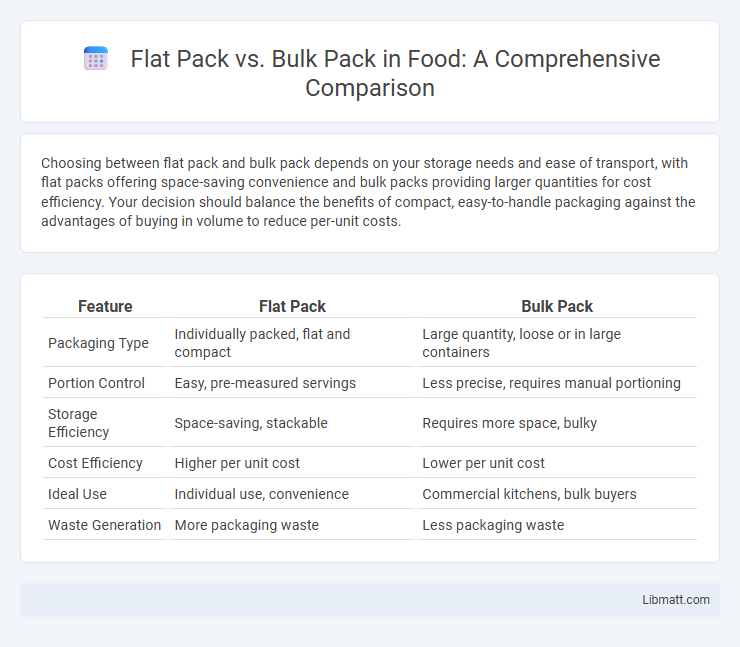Choosing between flat pack and bulk pack depends on your storage needs and ease of transport, with flat packs offering space-saving convenience and bulk packs providing larger quantities for cost efficiency. Your decision should balance the benefits of compact, easy-to-handle packaging against the advantages of buying in volume to reduce per-unit costs.
Table of Comparison
| Feature | Flat Pack | Bulk Pack |
|---|---|---|
| Packaging Type | Individually packed, flat and compact | Large quantity, loose or in large containers |
| Portion Control | Easy, pre-measured servings | Less precise, requires manual portioning |
| Storage Efficiency | Space-saving, stackable | Requires more space, bulky |
| Cost Efficiency | Higher per unit cost | Lower per unit cost |
| Ideal Use | Individual use, convenience | Commercial kitchens, bulk buyers |
| Waste Generation | More packaging waste | Less packaging waste |
Understanding Flat Pack and Bulk Pack
Flat Pack refers to products packaged in a compact, often disassembled form to optimize space and reduce shipping costs, commonly used in furniture and electronics industries. Bulk Pack involves items packaged in large quantities without individual packaging to minimize packaging material and cater to large volume buyers, frequently seen in wholesale and industrial supply chains. Understanding the distinctions between Flat Pack and Bulk Pack is crucial for supply chain management, cost efficiency, and inventory control.
Key Differences Between Flat Pack and Bulk Pack
Flat Pack products are disassembled items packaged in compact, flat boxes designed for easy transportation and space-saving storage, commonly used in furniture and electronics. Bulk Pack consists of multiple units packed together, often in larger boxes, aimed at wholesale distribution or retail stocking to reduce packaging waste and shipping costs. Key differences include packaging style, convenience of assembly, and target market efficiency, with Flat Packs prioritizing individual consumer use and Bulk Packs focusing on volume sales and logistics.
Advantages of Flat Pack Packaging
Flat pack packaging offers significant advantages including reduced shipping costs due to its compact and space-efficient design, which maximizes transportation efficiency and lowers freight expenses. It simplifies storage and inventory management by minimizing warehouse space requirements and enabling easier handling and stacking. Flat pack packaging also supports sustainability goals by reducing material usage and waste, contributing to a smaller carbon footprint throughout the supply chain.
Advantages of Bulk Pack Packaging
Bulk pack packaging reduces overall material costs by minimizing individual packaging layers, enhancing cost-efficiency for businesses. It supports sustainable practices by decreasing packaging waste and lowering transportation emissions due to optimized space utilization. This method improves handling and storage efficiency, enabling streamlined logistics and inventory management in large-scale distribution.
Cost Comparison: Flat Pack vs Bulk Pack
Bulk pack options typically offer a lower cost per unit compared to flat pack packaging, making them ideal for businesses looking to maximize savings on large orders. Flat pack designs reduce shipping and storage expenses due to their compact and space-efficient nature, which can offset higher per-unit prices. Your choice depends on balancing upfront product costs against long-term logistics savings to optimize overall expenditure.
Shipping and Storage Efficiency
Flat pack packaging maximizes shipping and storage efficiency by reducing volume and allowing products to be stacked compactly, lowering transportation costs and optimizing warehouse space. Bulk pack options, while less space-efficient, streamline handling and reduce packaging waste, benefiting high-volume shipments where unpacking speed is prioritized. Companies often select flat packs for cost-effective freight and storage, whereas bulk packs suit scenarios demanding rapid product deployment.
Environmental Impact: Which is Greener?
Flat pack packaging significantly reduces carbon emissions by optimizing space during transportation and minimizing material usage, resulting in a smaller environmental footprint compared to bulk pack packaging. Bulk packs often require more storage space and generate increased waste due to excess packaging materials and less efficient shipping processes. Choosing flat pack options supports sustainable logistics and resource conservation, making it the greener choice for environmentally conscious businesses and consumers.
Assembly and Installation Considerations
Flat pack products require careful assembly, often demanding tools and precise instructions to ensure structural stability, which can be time-consuming depending on your DIY skills. Bulk pack items typically come pre-assembled or with minimal setup, reducing installation time and labor but may require more storage space during transport. Choosing between flat pack and bulk pack impacts your installation efficiency and overall project timeline based on the complexity of assembly and your available resources.
Best Uses for Flat Pack vs Bulk Pack
Flat pack products are ideal for customers seeking cost-effective shipping and easy storage solutions, making them perfect for e-commerce and DIY assembly projects. Bulk pack options suit businesses that require large quantities for consistent inventory replenishment, such as retail stores or manufacturing facilities. Your choice depends on whether convenience in handling or volume purchasing is your primary need.
Choosing the Right Option for Your Business
Selecting between flat pack and bulk pack options depends on your business needs, storage capacity, and shipping requirements. Flat packs optimize inventory space and reduce shipping costs by packaging items in compact, disassembled forms, ideal for businesses with limited storage or high shipping expenses. Bulk packs offer convenience and speed for businesses prioritizing quick assembly and higher volume sales but may require more storage and incur higher shipping costs.
Flat Pack vs Bulk Pack Infographic

 libmatt.com
libmatt.com